If you notice water seeping into your basement where the wall and the floor meet, how bad is it? And what can you do?
The first thing to note is that the problem is not uncommon. On average, new homes develop leaks between 10 and 15 years after construction. A study by the American Society of Home Inspectors found that over 60% of basements have moisture seepage, with 38% experiencing mold and/or fungus growth due to an elevated moisture level.
Many older homes were built with inadequate waterproofing technology, making seepage ever more common, particularly after heavy rainfall. Indeed, if you live in your home for 30 years, you are five times more likely to experience a flooded basement than a fire.
As you can expect when it comes to water entering your home, it’s important to act quickly and to take drastic action (i.e. a temporary solution won’t cut it). This guide will show you why you need to address the problem, and what the best options for you are.
WHAT IS A COVE JOINT?
The most likely reason for water entering between the wall and the floor of a basement is that it is entering through the cove joint. The cove joint is where the wall and the floor meet in your basement. When the foundation is poured, the first step is to pour the basement walls. Only secondly is the basement floor poured.
Because of the way that the walls dry, there is a ‘keyway’ built into them, so that the floor ‘slots’ into place. The result of this process is a small gap between the floor and walls – this is known as the cove joint.
It’s perhaps not surprising that having a gap below ground level in a home is a dangerous situation – this gap is extremely susceptible to hydrostatic pressure from the groundwater outside.
WHY DOES A COVE JOINT LEAK?
Although it may seem like a design flaw to have a gap in your home below ground level, it usually takes a while before the pressure from groundwater can force its way in. The telltale signs of cove joint seepage are wet patches on your basement wall or floor (or, most commonly, both).
Heavy rain or even flooding can cause water pressure to build up in the ground surrounding your home. Once it has entered, however, it is unlikely to stop, and it is, therefore, time to act.
CONSEQUENCES OF COVE JOINT LEAKAGE
Because of hydrostatic pressure, a small leak can quickly become a large one. If not addressed, a cove joint leak can have the following consequences:

Structural damage to the walls and floors
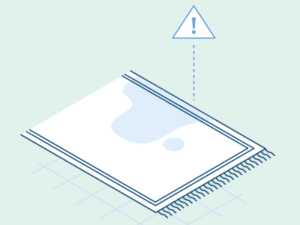
Warping of any hardwood floors or rotting carpets in the basement

Development of mold in the walls
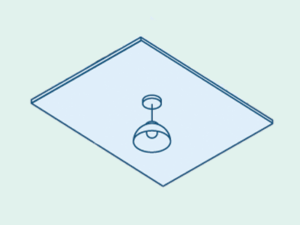
Damage to fixtures and fittings in the basement
PROBLEMS WITH SEALING A COVE JOINT
The most intuitive solution to a leak in the cove joint is simply to patch it up – to fix the leak. However, the problem is much larger than that. Water, even in small amounts, is immensely powerful, it will either find a way to bypass your patching or break through it.
The most common failures of cove joint sealing are:
New Entry Point
The water will enter your basement through other cracks in the foundation (or will make cracks in the foundation and enter that way).
Failed Application
The sealant will be forced off, and the water will continue to leak in through the same spot.
In both of these cases, the sealant may actively exacerbate the situation, making the leak greater in the long-term and causing more structural damage. Instead, you need to find a more permanent solution.
Here, you have two main courses of action:
Interior solutions
OR
Exterior solutions
INTERIOR
SOLUTIONS

Interior solutions are those that address the flow of water once it has entered the home. This is often the simplest (and therefore the cheapest) way of addressing the problem since it doesn’t involve re-routing groundwater or adding an additional structure to the outside of your home.
Interior Drain Tile
Interior drain tiles are the most common solution for a cove joint leak. In effect, these function like placing a gutter underneath your basement. Interior drain tiles are made with a flexible plastic pipe, designed to take the water leaking in and drain it out of your home.

The cost for this sort of system is usually between $2,000 and $6,000.
French Drain
A French drain is a trench covered with gravel or rock. Their job is to redirect water away from a specific area. French drains are both an indoor and outdoor solution. In most homes, French drains are installed on the outside of the home (or on joins, such as where the garage meets the driveway.
You can install these in your basement to keep the water from pooling in particular areas, and to also pipe it outside of your home.
French drains cost between $45 and $60 per foot to install, meaning the final bill usually comes in between $5,000 and $6,000.
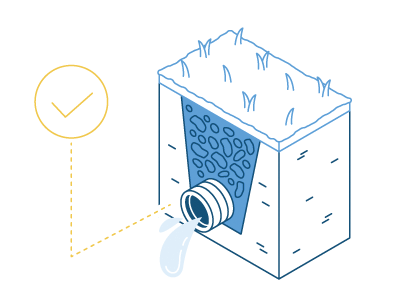
In order to install, contractors will need to dig up your basement, which potentially adds noise and inconvenience (particularly when contrasted with exterior drainage options).
Sump Pump
Installing a sump pump is another good indoor solution. It pushes the water out through the pipe (rather than letting it be pushed in through the cove joint).

Sump pumps can cost between $200 – $300. The installation of a sump pump basin in your basement can increase that cost significantly.
EXTERIOR
SOLUTIONS
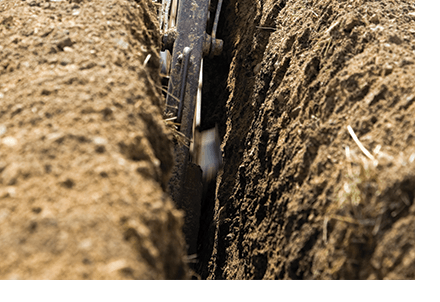
In some cases, it may be preferable to find an external solution to your cove joint problem. The fact that the problem is coming from outside means that a more permanent solution often involves stopping the water at the source, rather than attempting to vent after it has entered your basement.
Generally, external solutions are pricier than internal solutions, and so, depending on your budget, you may wish to consider the following options:
Waterproofing Membranes
If you are unable to waterproof your home from the inside, the most common exterior solution is to place a waterproof membrane around the outside of your home. As mentioned above, a partial patch won’t work, so this will involve surrounding the entire foundation with a membrane.
In order for this solution to work, you will need to excavate (i.e. dig down) so that the membrane can be installed on the outside of your foundations. Because of this, it can be difficult to do in situations where decks or garages are located next to the home.

A waterproofing membrane costs on average $3.34-$5.76 per square foot, meaning that the average range for this solution is between $2,000 and $6,320.
Exterior Drain Tile
There are pros and cons to choosing an exterior drain tile system to one on the inside of your basement:
- It can drain water further away from your home – preventing the ground from becoming saturated (and therefore starting the problem all over again)
- It doesn’t damage your basement
- You can combine it with the installation of a waterproofing membrane, meaning you only have to excavate once
However, because of the fact that it’s more labor-intensive, this option will almost always end up working out to be more expensive than an interior system.
The cost for an exterior drain tile can be anywhere from $800 to $8,000. Generally, you can expect to pay between $20 and $30 per foot for exterior drainage systems.
Create a Slope in Your Yard
Creating a slope in your yard is an attractive option as it’s something you can do without the need for professional help.
Digging down, attaching a sheet of waterproof plastic, and then creating a soil, mulch, and gravel slope on top of the sheet, away from your house is a relatively straightforward option.
The downside of this option is that, if not done absolutely perfectly (i.e. with no gaps) it will not solve the problem of a cove joint leak – although it may move it to a different part of your basement.
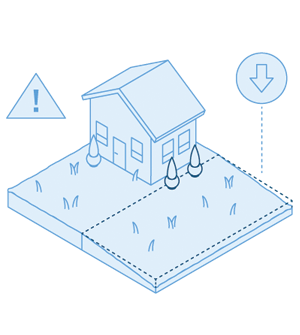
Fix Your Gutters
Fixing your gutters should be a complementary solution to all the others. Keep your gutters clean and ensure that they drain water at least eight feet from your home (more, if possible). This will help to prevent the groundwater immediately around your basement from becoming saturated, thereby reducing the hydrostatic pressure pushing on the basement.
The average cost to repair a cove joint can be anywhere between $200 and $15,000, meaning that you need to choose your solution based on your own budget and needs. Certainly, getting a cove joint fixed sooner will save you money in the long haul. The cost from the structural damage and damage from mold is likely to run into the thousands.
Whatever solution you decide – whether interior or exterior – it is unlikely to be covered by your insurance company. In some cases, your home warranty may cover the cost of structural defects, particularly if your home is a new build. Regardless of who foots the bill, it’s imperative to act quickly when you notice water leaking into your basement.
